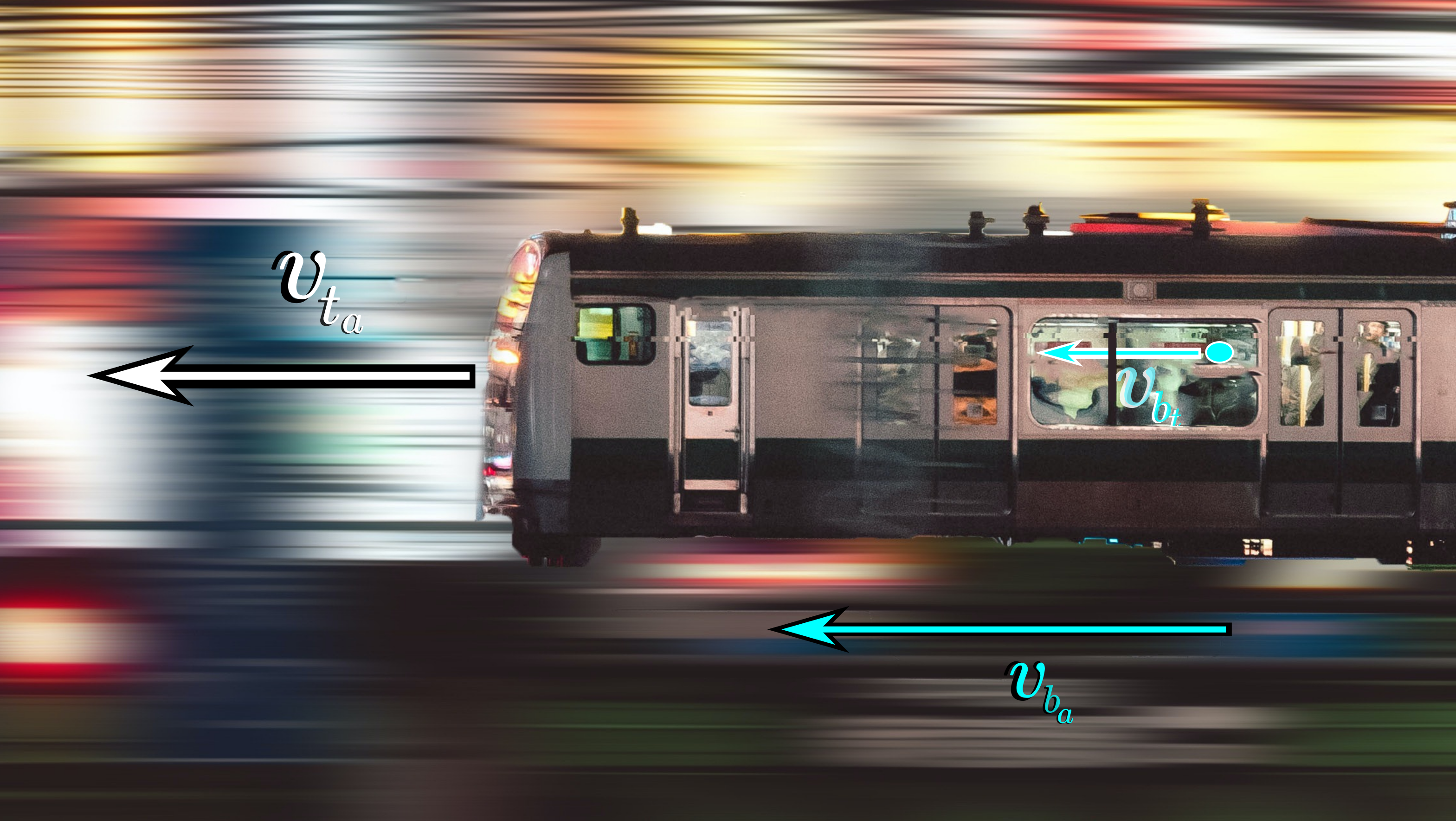The Four Working Principles of Special Relativity.

Special relativity, while paradigm shifting, doesn't require much math outside of algebra to understand at it's most basic level: that of constant relative velocity between reference frames. In fact, at this level, special relativity may be fully specified by four working concepts.
Some things you likely take for granted, in your perception of the universe, are provably wrong. Things you've likely never even considered due to their seemingly mundane existence as basic facts. The most shocking of these are likely the concept of a constant flow of time and the simulaneity of events for all observers. But other concepts, which are perhaps more nuanced, are also upheaved by similar considerations: such as the simple addition of relative velocities between several frames of reference, and the length of objects no matter their state of motion. These conceptual shifts will be stated explicitly below and justified through a single overarching theme of special relativity (and apparently the universe): that the speed of light (denoted c) is the same for all observers, no matter their relative speed to each other.
Velocity Addition
Our brains have basic Newtonian physics modules effectively baked in. And perhaps one of the most basic things one would suppose about the motion of objects is that velocities can be added linearly. Let's consider the motivation for a change in this concept: imagine a train somehow flashes past you at half the speed of light and you see someone on the train turn on a flashlight, with a linear addition of velocities, the light from the flashlight should appear to travel with one and a half times c relative to you. This, however, turns out to be patently false; the light must travel at c relative to you.
If you can't quite follow what I mean, consider this question: Alice is standing by a train track and she sees Bob, who's on the train, throwing a ball. If the train is moving at some velocity we'll call \(v_{t_a}\), and Bob throws the ball at some speed denoted \(v_{b_t}\) relative to the train (depicted below), how fast does alice see the ball travelling?

Obviously, the ball is just traveling at the sum of the two velocities (i.e. \(v_{b_a}\) should equal \( v_{t_a}+v_{b_t}\) ) right? It turns out, as an empirically verified fact, that this is incorrect. Alice will only see the ball traveling at the speed \(v_{b_a}\) given by the formula below:
This should seem counterintuitive, as it's hard coded into us that the sum of two velocities should just be the sum of the two velocities and certainly shouldn't be less than the two velocities; but it's neccesary to maintain the speed of light. This is hardly the most suprising relativistic effect however.
Length Contraction
Another basic intuition of the mind which we will call into question is that of the solid dimension of rigid objects. Now, we intuitively expect that a meter stick will (granted it's not broken or otherwised changed) remain a meter long. And that's whether it's here, sitting in a moving vehicle, or flying by us at any speed. But again, modern physics proclaims our intuition wrong; specifically, that when the meterstick's velocity relative to you changes, it's length (now specified as relative to you) changes as well.
Let us again consider a simple example to elucidate the topic at hand: An archer readys his bow with an arrow and in this moment the arrow is stationary to him. Then he fires and watches the arrow fly to it's target. Does the arrow, if we futher suppose that it is entirely rigid and thus is inelastic, change length at all through this process, relative to the archer?

Of course, our instinct tells us it shouldn't (on the condition of inelastic rigidity), but special relativity again contradicts us. In fact, the arrow's length relative to the archer actually is shorter the faster it travels (relative to him). This transformed length is described by the formula
This contraction only happens in the direction of travel, so the other dimensions of the rigid arrow are left unaltered to the archer. But this does hold for all objects. And of course, at our ranges of motion, this is again imperceptible and unmeasurable. The arrow's contraction below is exaggerated for effect.

Even for a projectile fired by a rifle, moving at 3000 ft/s, the length of the bullet isn't even shortened by 0.000000001% its stationary length. However, lengths can be contracted to arbitrarily small scales as they approach the speed of light. For example, if a train did flash by you at half of c (~\(4.4\times 10^8\) ft/s), the length of the train would be 86% its original length. For a train moving at nine tenths the speed of light, the length would be contracted to only 46% it's stationary length relative to you. That's less than half it's original length! And even still, this isn't yet the most astouding implication of special relativity.
Time Dilation
The flow of time itself is also altered in the paradigm of special relativity. Again, our intuition expects that a perfect watch on my wrist would tick at the same rate as one on my friend's, regardless of what we were doing respective of each other. But alas, things cannot be so simple. Indeed the faster he travels relative to me, the slower his watch ticks relative to mine.

Let's consider a scenario in which we're having coffee and some passerby on a subway sees us. Now, we're busy professionals so we're trained to and do gulp down our coffee in exactly 10 seconds as the train passes. How long does it take us to drink the coffee according to the person sitting on the train?

Of course, intuition says 10 seconds (that is, as long as we take to drink the coffee ourselves). However, as aluded to above, this intuition again is only suited for small velocties. In fact, the time it would appear to take me to drink the coffee to someone on the train (going \(v_t\) relative to us) can be calculated with the following formula:
This is a neglible effect for velocities under say thirty million meters per second (which only results in a 0.5% difference in the time interval), but for a train moving at 99.99% of c we'd seem to be drinking the coffee for almost twelve minutes!
Amazingly, this allows one to effectively 'time travel' into the future of humanity. Since everyone on Earth is moving within a reasonably bounded velocity with respect to one another, we can take humanity itself to have some reference frame that we'll take to be inertial. Then, for an individual to travel into the future of humanity, they need only to move somewhere close to the speed of light for some proportional amount of time. (For a more detailed explanation see resources on the "Twins Paradox" of special relativity. A real treatment of this topic would require acceleration for the individual moving to return to Earth and compare clocks again.)
Rear Clock Ahead Effect
This is perhaps the most jarring effect of all those in our discussion. It's conceptually equivalent to the loss of simultaneity (though a more functional title in that it reminds you in which direction things are now favored). If a train goes passing by, our brain suggests instinctively that all that is simultaneous in our view should also be simultaneous to a passenger on the train. This, however, is not true. In fact, the events which are simultaneous to those on the train are offset by a determinable time, in the view of those standing along side it, such that those events appear to happen first in the rear of the train and then in the front.
Consider this: There's two people on a train, they look at each other across the whole car and say hello at exactly the same time. Now, you're standing beside the train and watching them (again). Do you see them speak at the exact same time?

Of course you should, right? Indeed most would think you should, but the special theory of relativity says otherwise. In fact, you'll actually see the person at the rear of the train say hello a short time, \(\Delta t_{RCA}\), before the person at the front of the train even looks at them. This time is given by the relation
Further Comments & Resources
This discussion of the basic effects of special relativity really only scratches the surface of what people mean when they speak of relativistic effects. However, these generally are the concepts called into question by relativistic theories. Velocities, lengths, time intervals, and simultaneity really must be specified relative to some frame of reference. Here we've only dealt with constant velocity differences, absent of any acceleration. This is the most basic case of special relativity and it all approaches, in the limit of small velocities, our physical intuition and classical Newtonian dynamics. Cases of linear acceleration are still within the scope of these effects, but treatments of those require the use of calculus, and no new mind-bending concepts are really introduced.
General relativity is the further consideration of non-inertial frames as well as the inclusion of gravity (which will turn out to affect the same things, namely the relative flow of time and spatial dimension) but that requires differential geometry and consequently is much harder to deal with. Although it is beautiful in comparison to modern quantum theories (which are, as of yet, divorced from general relativity).
For interested parties seeking a more technical overview and formal treatment of this subject, David Morin has a wonderful introductory text that covers these same topics in the first chapter.
